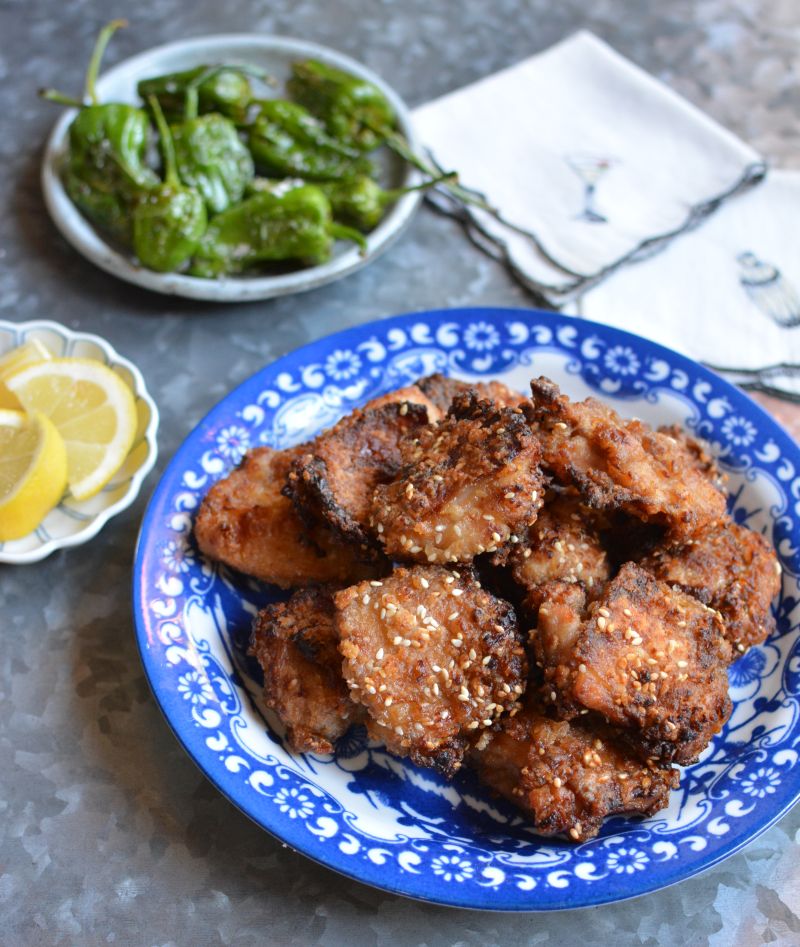
We cook and eat for a whole host of reasons but today I wanted Japanese fried chicken. I felt celebratory because yesterday, Vietnamese Food Any Day went to print! Then late last evening, I received news that after thirty-one years, Cooking Light will cease its print magazine. That means my monthly column will be gone after December 2018, but sadder yet is the fact that my friends and colleagues just suddenly lost their jobs! The food media world is hurting financially and Cooking Light will merge its subscribers with that of Eating Well, a sister publication. The business decision was made by Meredith Corporation, their parent company.
That said, I was feeling really off and needed a delicious distraction. So I picked myself up by the air-fryer, sort to speak. It was my Cooking Light editor, Brierley Horton, who got me to go whole hog to review air-fryers and ever since then, I’ve gotten hooked on playing with it. My latest experiments have been with Japanese fried chicken – kara-age, a popular snack with drinks (you’ve likely seen on Japanese menus) that’s also great with rice for dinner. What you're looking at here is my third round of air-fried Japanese fried chicken.
A Proper Name for Japanese Fried Chicken
Kara-age is easier to make than tempura because there’s no batter, say Tadashi Ono and Harris Salat in their terrific book, Japanese Soul Cooking. The term kara-age refers to a generic group of deep-fried foods that are simply seasoned, dredged in starch or starch and fried. It’s more common than tempura and enjoyed all over Japan.
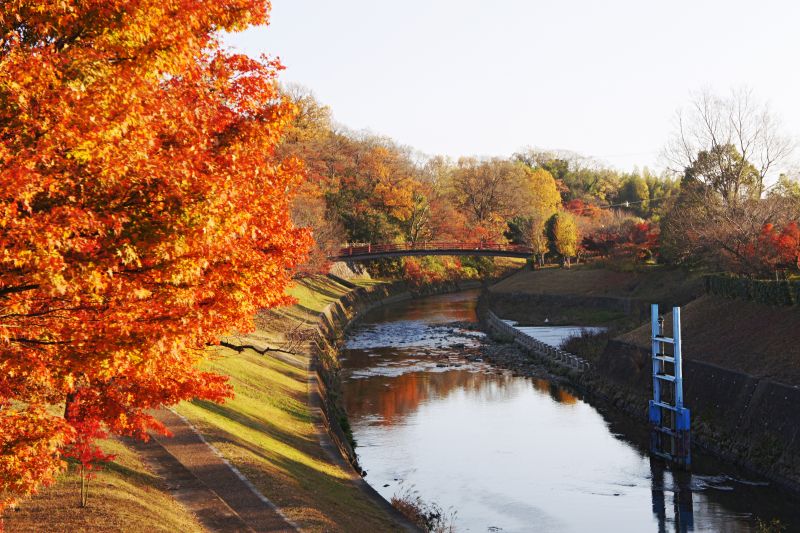
Though kara-age is a general term, we often think of it as referring to Japanese fried chicken, but the delicately crisp morsels should really be called tatsuta-age, or chicken tatsuta. Tatsuta is the name of a river known for russet colored leaves that float down during autumn. The rich color inspires the color of the fried chicken. The Japanese are so poetic even with humble fried chicken. If you call this by its popular name, kara-age, you won't be wrong. If you go with tatsuta-age, you may win new friends!
How to Debone Chicken Legs and Other Pointers
The fact that there’s no messy batter involved got me wondering about air-frying the chicken. The air-fryer is perfect for surrounding the coated chicken with hot air. Instead of a pot of hot oil, I just needed to moisten the chicken and let the air-fryer do the rest.
In Ono and Salat’s recipe, skin-on, dark meat chicken is marinated with lots of garlic, ginger, soy, mirin, and sake.
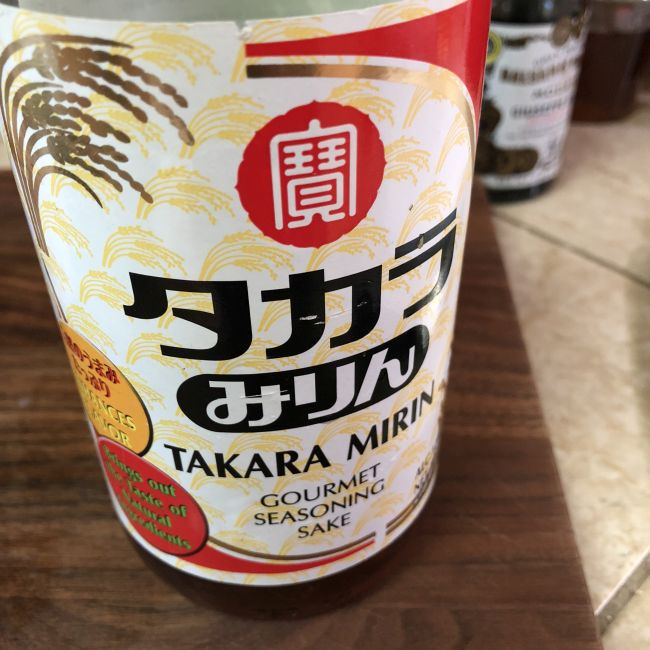
If you shop at a Japanese market like Mitsuwa or Nijiya, you can buy the chicken already prepped for kara-age. Otherwise, just do it yourself with a boning knife like this one.
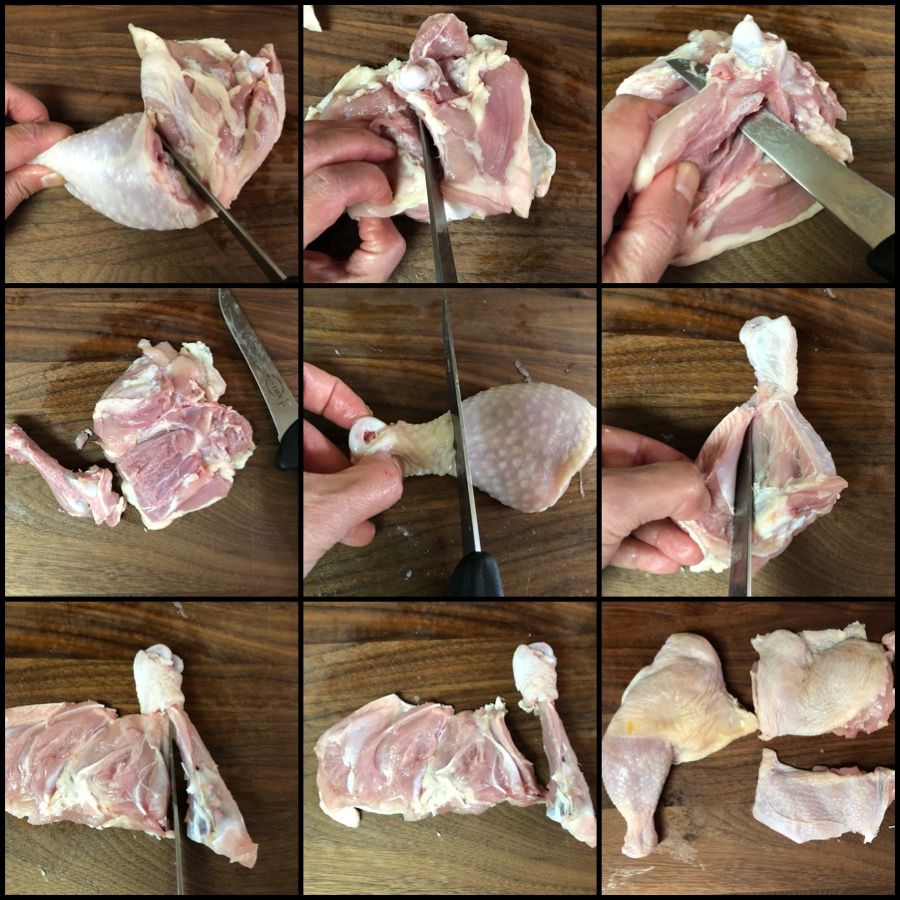
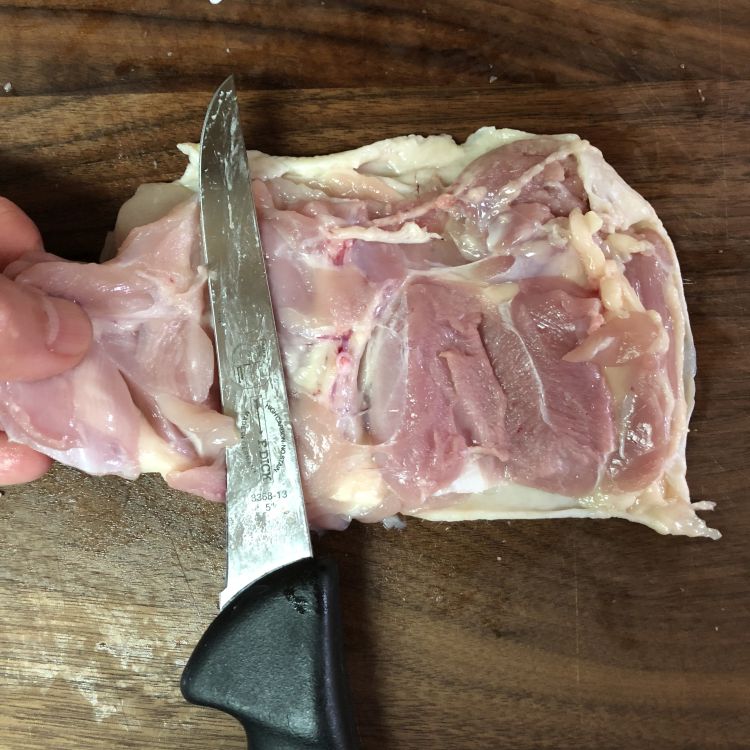
I had a robust dark Japanese soy sauce so I used it for the marinade, which explains the dark color result. If you have supermarket Kikkoman soy sauce, that will work just fine.
The Japanese have very fine potato starch – katakuriko, but I simply used Bob’s Red Mill brand which is available at natural grocers and well-stocked markets. Bob’s seems to create a slightly thicker, crisper finish on the chicken than when I’ve made it with Japanese potato starch.
The air-fryer does a remarkable job with circulating tons of hot air to fry the chicken fast. I used very little oil and flavor and texture-wise, there was little difference between the air-fried Japanese fried chicken and the regular deep-fried version.
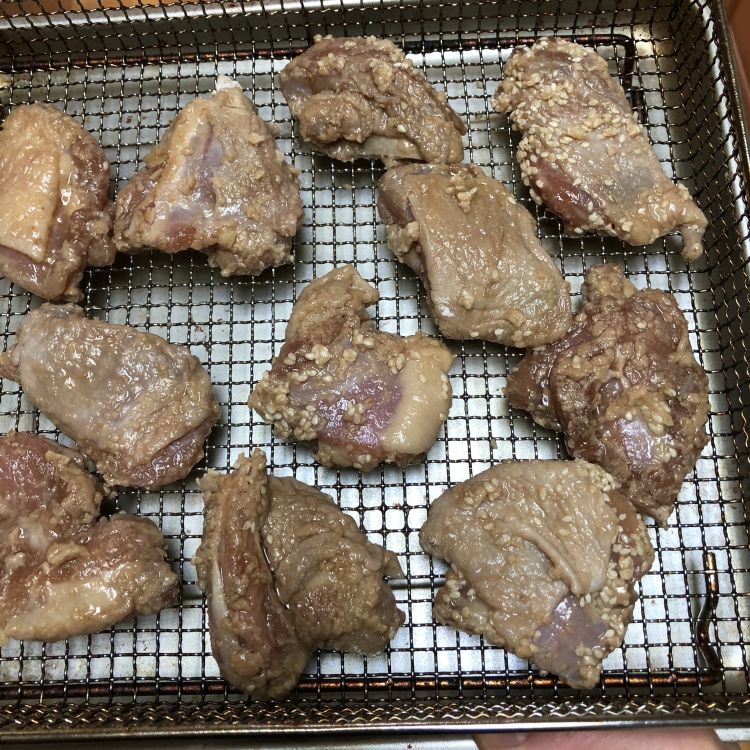
For fun, I air-fried some peppers to serve with the chicken. Together, they were a great pairing. The lemon brightens things but you may not need it. I often squirt it on the deep-fried chicken but the air-fried rendition didn’t need much.
Air-frying the Fried Chicken
I used a large-ish capacity Cuisinart convection oven air-fryer, which comes with analog-style knobs and more precise digital controls. If you air-fry in a smaller machine, cook the Japanese fried chicken in two batches. It holds its texture for a while and you can always slightly under cook the first batch and reheat it after the second one is done.
Don’t have an air-fryer? Deep-fry the chicken for about 5 minutes at 340F (aim for slightly below 350F). At that temperature, the chicken crisps without burning (too hot of oil) or turning soggy (the oil is not hot enough).
This is an easy-going recipe that you can whip up and fry any time. Use skin-on chicken because the fat adds lusciousness and crispy goodness.
Japanese Fried Chicken (Kara-age, Tatsuta-age)
Yield 2 to 4 servings
Let the chicken hang out overnight in the marinade for deeper flavor. Air-chilled chicken has relatively thin skin so it fries up delicately crisp. For 1 pound of chicken, debone a generous 1 ⅓ pounds chicken legs, drumsticks or thighs.
Ingredients
- 1 pound boneless, skin-on chicken leg and thighs
- 1 garlic clove, grated
- 2 teaspoons grated, peeled fresh ginger
- ¼ teaspoon fine sea salt
- 2 tablespoons sake
- 2 tablespoons soy sauce, preferably Japanese shoyu
- 1 tablespoon mirin
- ½ cup potato starch
- 1 ½ tablespoons sesame seeds (optional)
- 2 ½ tablespoons neutral oil, or 2 tablespoons neutral oil plus 1 ½ teaspoon toasted sesame oil, plus more as needed
- 6 to 8 Shishito or Padron peppers
- 1 small lemon, cut into wedged (optional)
Instructions
- Pat the chicken dry with paper towel, then cut into 2-inch pieces. Set aside.
- In a bowl, stir together the garlic, ginger, salt, sake, soy sauce, and mirin. Add the chicken pieces and turn to coat well. Cover and set aside for 30 minutes, or refrigerate up to 24 hours (return to room temperature before cooking).
- In a bowl, combine the potato starch and sesame seeds (if using). Drain the chicken of the marinade, then dredge each piece in the starch mixture, shaking off excess starch. (You can put the starch mixture in a plastic zip-top bag and shake the chicken in it.) Put the coated chicken on a baking sheet or plate as you work.
- Drizzle half the oil on the chicken. Use tongs, chopsticks or your fingers to turn the chicken, then drizzle on the remaining oil. Turn the chicken so the pieces all look wet (a sign the oil has coated them). If there’s a little starch left, you can dip pieces in the starch again, especially if they look like they weren’t touched by starch.
- Place the chicken pieces, skin side down with space between each, on an air-fryer rack (or in the air-fryer if your model does not have a rack). Preheat the air-fryer to 350F for about 3 minutes, then slide the chicken in the air-fryer. Cook for 4 to 5 minutes, until gently hissing. Turn the chicken so the skin is facing upward. Air-fry for 3 to 4 minutes longer until brown on top. Check the browning and crisping during the last 1 or 2 minutes and increase the heat to 375F to blast the pieces a bit more.
- Remove from the oven, let rest for 3 to 5 minutes, then transfer to a plate. If you’re serving with the peppers, toss them in splash of oil, then air-fry at 400F for 2 minutes, until blistered with maybe some brown spots. Transfer to a plate, sprinkle with salt and serve with the chicken and lemon wedges.
Notes
Based on a recipe in Japanese Soul Cooking by Tadashi Ono and Harris Salat
Courses snack or dinner
Cuisine japanese
















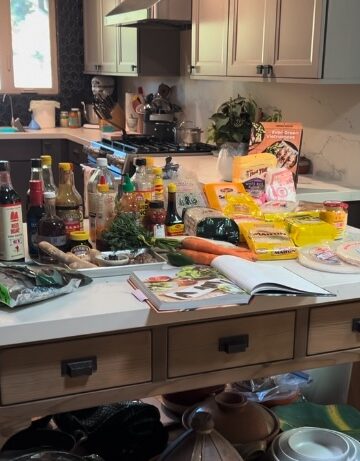
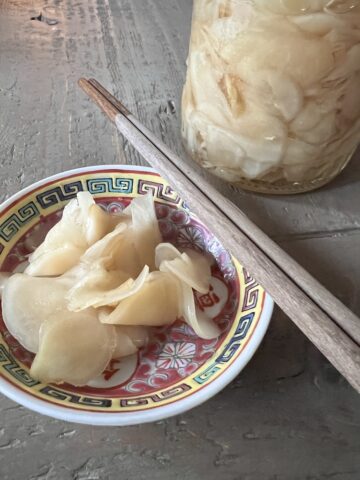
Elizabeth Andoh says
Congrats (or, omedeto, as they say in Japan) on launching your new book! Delighted to hear you want to celebrate with Japanese fried chicken. Your photo-illustrated deboning technique is terrific. I struggle with it when I am visiting the USA (I am spoiled since I can get boneless-but-skin-on dark meat chicken at any market in Japan) and will find your instructions a boon. MANY THANKS!
Andrea Nguyen says
Right? American supermarkets are into boneless skinless thighs but it's the skin that I want! Whatcha gonna do but shop at a Japanese market or do it yourself? Thanks for the congrats, Elizabeth.
Jeanette M says
Congratulations on your book! I look forward to buy the Kindle version. I’ve loved your other books and am certain this one will be no different. You have a gift for making complex cooking simple enough to try. Thank you!
I’m genuinely sorry to hear about Cooking Light. I’m a digital subscriber and have loved this publication since its inception. Your column has been one of my favorites and will be sorely missed. However, God never closes a door without opening a window. I pray for the best for you and all of your colleagues.
Andrea Nguyen says
Thank you Jeanette for taking time to write such a kind note! We cook and eat is weird times. CL was a practical publication with solid information to help people cook, eat and live healthy lives. Hopefully, Eating Well will incorporate some of that too!
Kat Hanson says
This looks amazing! I often lose inspiration so thanls to Cooking Light and to you for sharing. One thing, your soy sauce doesn't say gluten free. Is that type naturally GF? Otherwise this recipe is not GF. I love using GF tamari instead for a real depth of flavor. 🙂
Andrea Nguyen says
Just because a soy sauce is labeled tamari doesn't meant it's GF. For gluten-free soy sauce, Kikkoman, which is sold at regular supermarkets, is terrific. Here's a gluten-free soy sauce and tamari tasting that I did a little while ago: https://www.vietworldkitchen.com/blog/2015/02/gluten-free-soy-sauce-tamari-guide.html
Mickie says
I just stumbled upon your website, I love it! Thank you!, Andrea! I look forward to trying some of your recipes,
Andrea Nguyen says
Welcome, Mickie!